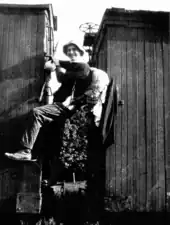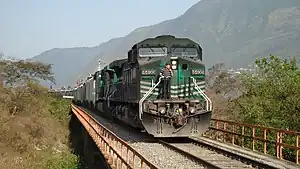Freighthopping
Freighthopping or trainhopping is the act of surreptitiously boarding and riding a freightcar, which is usually illegal.

History
Illegally hopping a ride on a private freight car began with the advent of trains. In the United States, freighthopping became a common means of transportation following the American Civil War as the railroads began pushing westward, especially among migrant workers who became known as "hobos". It continued to be widely used by those unable to afford other transportation, especially during times of widespread economic dislocation such as the Great Depression. The practice was heralded in popular culture of 20th century America with songs such as "King of the Road", and films like Emperor of the North Pole. For a variety of reasons the practice is less common in the 21st century, although a community of freight-train riders still exists.[1]
Typically, hoppers will go to a rail yard where trains stop to pick up and unload freight and switch out crew. They will either board a freight car in some fashion unseen or “catch one on the fly” once it has begun to move.[2] Train surfing is a similar activity that involves the act of riding on the outside of a moving train, tram or another rail transport.
Riding the rods

Most train hoppers simply rode in or above freight cars. Another historic method was “riding the rods“. In the early 1900s days of wood frame freight car construction, steel truss rods were used to support the underside of the car in order to provide it with the strength to carry heavy loads. There could be four or more of these truss rods under the car floor running the length of the car, and hobos would “ride the rods”. Some would carry a board to place across the rods to lie on. Others would lie on just one rod and hold on tightly. Riding the rods was very dangerous. When a train moved at high speed, the cars could bounce and rock violently if the track was rough, and rock ballast might be tossed up which could strike a rider.
Dangers

Riding outside a freight car, whether atop or underneath, is dangerous.[3] Being in a loaded car with shifting, heavy cargo can also be dangerous.
The 1944 Balvano train disaster in Italy involved (and was partially caused by) hundreds of freighthoppers.
Today
Hopping trains happens all over the world and varies from place to place. Some places are more critical and consider freight hopping a crime, and other places are more lenient.
- Europe
Despite increased deterrent measures, would-be migrants use the Eurostar[4] and Eurotunnel Shuttle[5] to cross the English Channel from France to England.
- United States
Union Pacific Railroad in the United States encourages people who witness transients on freight trains to report them to its dispatch center. According to a sheriff's deputy from Lincoln County, Nebraska train hoppers no longer write symbols on trees and buildings, but there is still a network of train hoppers that occurs mostly online.[6]
- Mexico

It is estimated that yearly between 400,000 and 500,000 migrants—the majority of whom are from El Salvador, Guatemala, and Honduras—hop freight trains in the effort to reach the United States.[7][8] The freight trains are known as La Bestia.
- Mauritania
In the Mauritania Railway, freighthoppers can ride with their cargo freely due to the lack of road between Zouérat and Nouadhibou.[9]
See also
- Ben Reitman, the “hobo doctor”
- Mike Brodie, freighthopping photographer
- W. H. Davies, the "tramp-poet"
References
- "Black Butte Center for Railroad Culture". Bbcrc.org. Retrieved 2015-07-08.
- Iverson, Wayne (2010). Hobo Sapien. Robert Reed Publishers. ISBN 978-1-934759-43-1.
- "Boy Critically Injured Trying to Jump Train in Northeast Philly". Newsworks.org. Associated Press. Retrieved 2017-07-22.
- "Stowaways make 240-mile journey beneath Eurostar". Independent.co.uk. 11 June 1997.
- "Stowaways foil tunnel security". TheGuardian.com. 10 April 2002.
- Johnson, Heather (August 28, 2018). "Ridin' the rails". The North Platte Telegraph.
- Sorrentino, Joseph. "Train of the Unknowns". Commonweal. Retrieved 25 May 2013.
- "Invisible Victims: Migrants on the Move in Mexico". Amnesty International Publishers. Retrieved 25 May 2013.
- Mykolas, Juodele. "Freight Train Hopping In Mauritania: 4000 Kilometers In A Cargo Carriage With Local Shepherds And Their Sheep". Bored Panda. Retrieved 2020-12-21.
Further reading
- Uys, Errol Lincoln (2003). Riding the Rails: Teenagers on the Move During the Great Depression: Routledge. ISBN 0415945755
- "Riding the Rails", American Experience PBS series.
- Conover, Ted (2001). Rolling Nowhere: Riding the Rails with America’s Hoboes. Vintage. ISBN 0375727868
External links
- Hobo Letters Letters from boxcar kids who rode the rails during the Great Depression